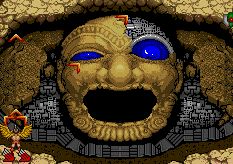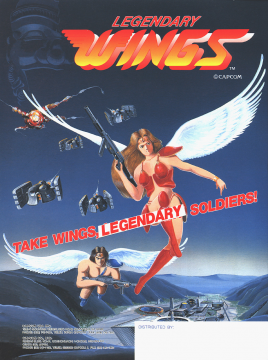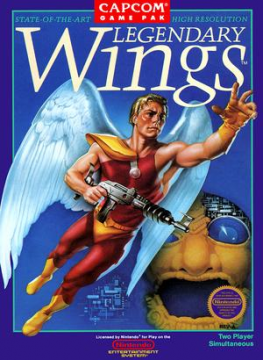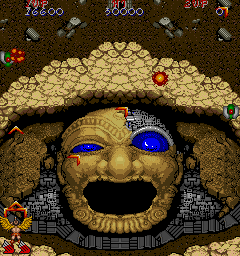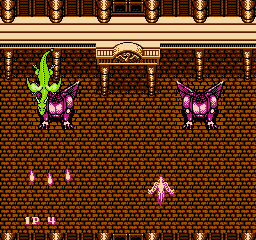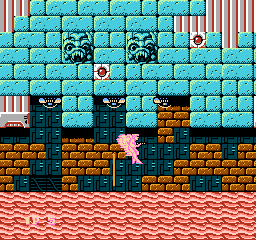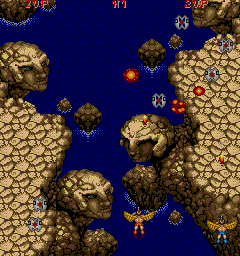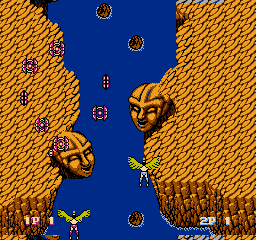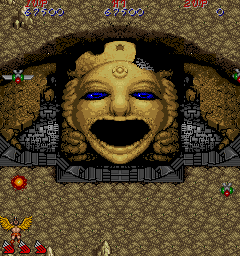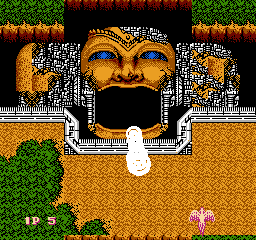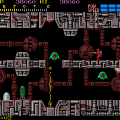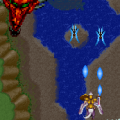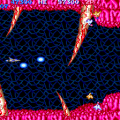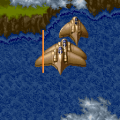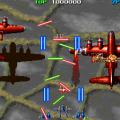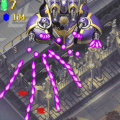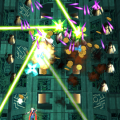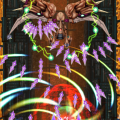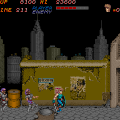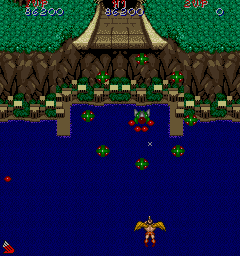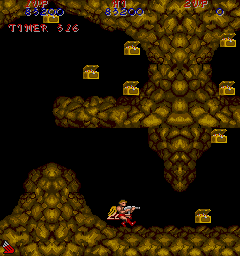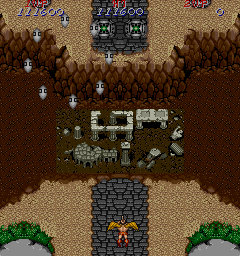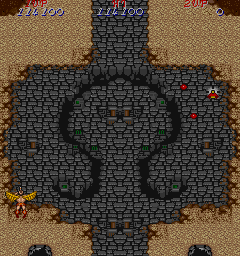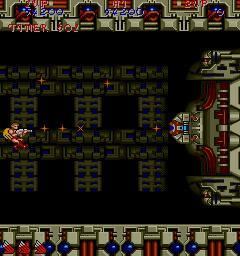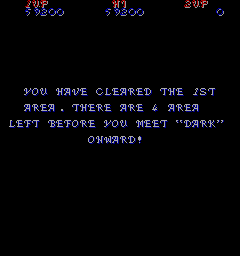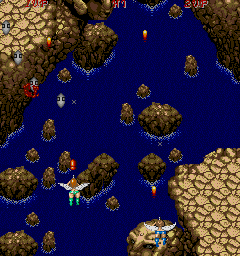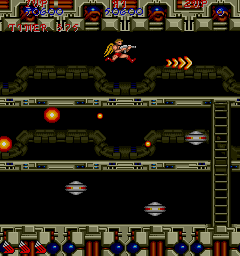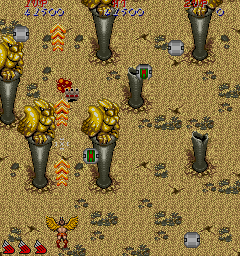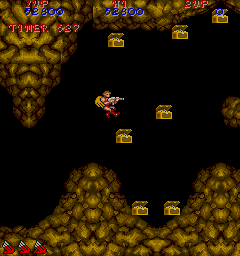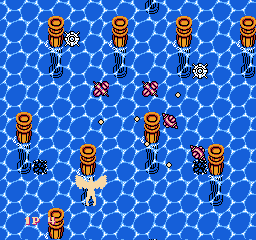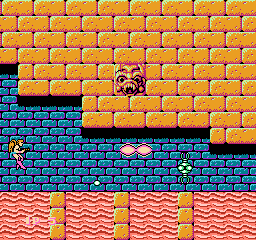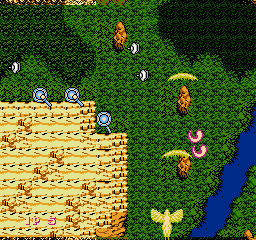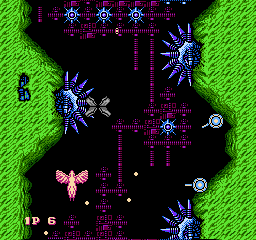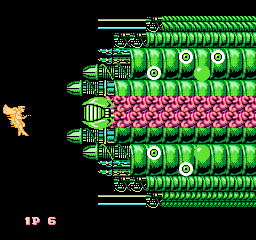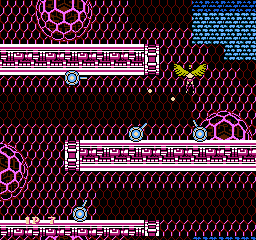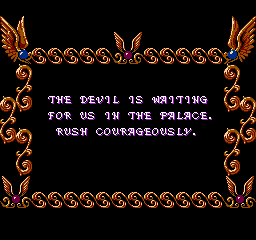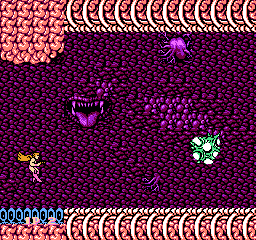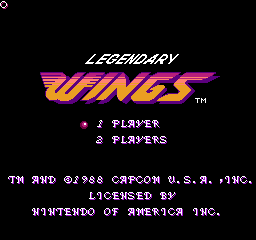Though Capcom put out a number of arcade shoot-em-ups in the mid-80s, Legendary Wings is one of the titles that doesn’t seem to be recognized very often. This is unfortunate as it is a pretty interesting game, plus it was one of the titles designed by Mega Man creator Akira Kitamura. What’s even more interesting is that the NES version is an improvement over the original, which is not unbelievable considering Capcom’s later reworking of the okay Bionic Commando into a completely different and much superior game on the NES.
The plot is generally what you would expect from this sort of game, though the setting built around it is something considerably different from the norm. In the far future, a supercomputer ominously entitled “Dark” appears to be helping out humanity when, unsurprisingly, it goes completely nuts and starts waging war on mankind. The curious bit is that instead of fighter pilots heading in to wreck up the machine’s army, the Greek god of war, Ares, entrusts the Wings of Love and Courage to the use of two powerful young warriors in the hopes that they can infiltrate Dark’s armada and blow up the homicidal AI. This lends to the game’s unique visual design which blends a Grecian fantasy landscape with advanced technology, combining rocky terrain and lush plains with mechanical turrets and giant computerized fortresses. The graphics are fairly attractive for the time the game was released, even if there’s nothing incredibly spectacular to behold outside of the massive faces whose presence will be explained later. There’s not too much to say about the sound design either, as while there’s a bit of decent music in there, it sounds a bit mute and is often eclipsed by the loud sound effects.
Legendary Wings plays as an overhead shooter for about half the time and an offbeat run-and-gun for the other half. The vertical segments are pretty straightforward: As one of the two winged warriors, fly around at shoot at aerial enemies with your gun and drops bombs on ground units, akin to the classic shooter Xevious. Shooting certain formations of enemies or turrets will give you P symbols, and if you collect two, your main gun jumps up one level. It goes from a basic weak singular shot to a twin shot, a three-way arrow shot, and ending on a powerful laser which wipes through nearly every enemy in one projectile. Around the midpoint of each stage, you will encounter a simultaneously awesome and creepy stone face that is partially made of robotic bits. It opens its mouth and if you get too close to that big gaping black hole, you fall into the “DANGER” zone, one of three aforementioned side-scrolling bits full of nasty enemies in a rather dark tunnel. The walls are made of bones and the background appears vaguely Giger-esque, though the only two enemies you ever seem to face in these areas are worm dragon things that spit fire and large shelled bugs which bump you around and take many hits to kill. Your flight is disabled during these scenes as you have little room to fly, and you must instead jump around and climb ladders to navigate three tiers and get to the end of the area. You gain flight to fight the guardian of these areas, some sort of odd core thing which fires spread shots until it dies or you do. However, you should really attempt to avoid the Danger zones in the first place as they do little more than waste your time and lives.
If you manage to uncover a hole beneath an enemy ground turret, fly into it to activate another side-scrolling bit, the “LUCKY” stage, which is a bonus area full of point items to boost your score and perhaps earn you a bonus life. During these areas, you have absolute free roam and can fly as if you were fighting the boss, except you don’t have to fight anything in these areas. You DO have to watch out about getting stuck behind terrain and being effectively squished between rocky mounds and the edge of the screen, but this usually only happens if you get too greedy. Past the lucky area is the end of the vertical level, which is always guarded by two statues that fire many projectiles and can only be hit by your bombs. Destroy the statues at the end of the vertical level to infiltrate the enemy palace, yet another side-scrolling part that is structured very similar to the Danger level. It has a distinctly more mechanical flavor and with different enemies, like eye robots that spit out fire and indestructible energy balls which actually expand if you hit them. The end boss in these bits is some sort of mechanical eye-core thingy that can be demolished if you’re at your maximum power, but it takes a bit more effort if you have a lesser weapon.
And that’s the basic structure of Legendary Wings. It’s five stages long, and none of the stages are too big (unless you get warped into a Danger hole), but if you lose all your lives, you have to restart the entire level when you continue. It gets worse considering that you can only take one hit with no sort of shields to help you, and the enemy flow becomes gratuitous in later levels. However, the horizontal bits are even worse, considering how stiff the movement is and how enclosed the action feels, making it difficult to adequately dodge enemy attacks. There really isn’t much variety in these bits either, with later Danger and palace levels looking exactly the same to each other and simply dialing up the enemy dial. It probably would have helped the game’s pace if these segments were also made as pure flying shooters instead of forcing your angel to walk around everywhere. In total, Legendary Wings is a fairly interesting shooter that is notable for being one of the earlier games to combine both vertical and horizontal shmups into a single game, even if the horizontal parts restrict your flight. However, its obnoxious difficulty and overall repetitious nature makes the final product a bit disappointing and insubstantial. While far from Capcom’s worst game ever made, Legendary Wings is a remarkably average title that isn’t worth a play for all but diehard shooter fans… at least the original arcade version.
Two years later, Capcom’s focus was a bit more attuned to the NES and amongst releasing original titles for it (with Mega Man being foremost prominent), they remade a few of their arcade classics: Trojan, 1943, Section Z, Gun.Smoke, and somehow, Legendary Wings got a second chance. This time, the developers managed to fashion a respectable game that ranked far above average and became one of the better shoot-em-ups for the console. It makes several changes: Some notable, some subtle, and all appreciated. To start, the aesthetics, while technically less advanced than the arcade original, better compliment the overall game design with a brighter palette and more flavor in the landscapes. The levels are more memorable with a distinct color theme prevailing in each: Yellow-orange for the arid mountains of the first level, deep blue for the oceans of the second, lush green for the forests of the third and so on.
Both the Danger and end stage palace areas now allow full flight without having to worry about a jump button, and these segments are generally better designed with more obstacle variety and less overall frustration. They also look very different from each other, with the Danger zones now taking on a grotesque nightmare theme with an unsettling magenta background that looks like a bunch of blood cells dotted with anatomical hearts and inhuman mouths agape in vile grins. The palace segments are heralded with the following Engrish: “The Devil is waiting for us in the palace. Rush courageously.” These areas invariably take on some sort of techno-Mesopotamian theme with ancient statues and sand dunes mixed with steel plates and glowing LEDs. A nice touch is that the older elements of design are gradually minimized in lieu of the more technological aspects for the later palaces, with the final palace being absolutely mechanical with no trace of past-world construction present.
The Lucky levels have even been changed around a bit, now taking on a distinctly Egyptian theme with hieroglyphs and pharaoh engravings all over the background, and you collect birds, snakes, and masks for point items. You can even snag power-up icons and hearts that allow you to use more continues, quite valuable if you intend to see this game to the end. There’s even a jaunty Egypt-beat tune playing during these segments which is simple yet catchy, as is the rest of the soundtrack. The NES’s technically inferior sound processor makes up for its lack of power by making the music louder and more prominent alongside the sounds, and something about it just sounds better alongside the demure arcade music. It’s hard to pick any one tune that stands out, though perhaps the most infamous is the Danger zone music which is one of the overall creepiest tunes composed on the NES and makes these already traumatizing segments even more disturbing. The curious thing is that most of the tracks (save for the new Lucky tune) were taken from the arcade version, but through some uncanny force of nature, they stand out more on home hardware.
The most graciously fixed detail is the difficulty, which was previously too dang steep for most gamers to appreciate. While still tough, the NES Legendary Wings curbs the challenge to be less punishing outright and more encouraging. For starters, you merely need to collect one power-up token instead of two to bolster your gun, and the upgrades are even better than what the arcade game gives you. Furthermore, you don’t instantly die if you take damage; you merely regress one power level, though if you get hit while at your lowest level, that’s an actual life lost. Boosting your main gun power also increases the speed and range of your bombs, which also don’t have to land on enemies with direct aim in order to register a hit. Your basic gun is what it is, but the second level fires a potent twin laser that makes a quirky “buzz” sound every time it’s fired. The third level is a strong straight beam that fires incredibly quick, and the fourth level is a trio of fire balls which have a wide spread of attack. The fifth and final level actually wreathes your character in fire so as to make them appear as a legendary bird made entirely of flame. This turns your shot into a massively powerful fire wave that can tear through the toughest of enemies, and you take three whole hits before losing your power, though this “lifebar” can be rejuvenated by picking up another P symbol.
Your better power potential is also complimented by less vicious enemies. The arcade version would often send out small pests which spat bullets and darted around the screen while ground units would heap even more projectiles into the action. Here, the action doesn’t get quite as off the wall and sends lesser enemy waves at you as you travel. To offset this, the vertical levels are significantly longer than they originally were, but this makes the game feel bigger while also allowing the programmers to spread out the difficulty over a longer period of time. You get some annoying enemies from time to time, like these indestructible stone wing obstacles and turrets which you can’t turn backwards to hit, but the difficulty is still overall fairer with the ability to sustain several hits at the cost of your current power level. That being said, losing all your lives plops you back to the beginning of the level as in the arcade, and you now have limited continues to comfort your losses. These continues can be restored if you manage to find the Lucky area for each level, however.
While not too much improved, the NES port does bolster things a bit on the boss front. Instead of a mere brainy core at the end of each Danger area, you take on a duo of giant worms in a super-bizarre dark room surrounded by what looks like a bunch of blue tapioca pudding. They can rear their head out of nearly any surface of the enclosed room and spit out harmful bubbles, though they can be killed quickly if your weapon is fitting. At the end of each vertical segment, after destroying the twin statue heads, a dragon flies out to assault you, flying about in a vague infinity symbol-pattern while blasting out fire and periodically diving towards you at fast speed. Finally, at the end of every palace segment, instead of fighting an easily demolished techno-eye thingy that looks ripped right out of Gradius, you instead take on a hulking battleship that appears to be centrally comprised of brain matter and launches out infinite eyeballs until you destroy its main core, which opens up to blast out deadly brain bits in a large spread. This is certainly one of the most awesome and disturbing sights on any NES game, though the novelty does wear off considering that these bosses repeat themselves for each of the five stages. However, the dragons and brain battleship thingy do at least change color and become noticeably more aggressive for each new stage, and you even have an additional battle at the very end against a teleporting core that may or may not be Dark. It’s a bit of a disappointing final boss, but at least it’s something new and can be pressuring if you’re almost out of lives at this point.
There would be several more shoot-em-ups for the NES offering considerably more weapons, stages, mechanics, enemies and bosses over Legendary Wings, but it just retains an indescribable charm that makes it a fascinating game in spite of its faults. When it comes to NES shooters, Legendary Wings is the way to go for simplicity, entertainment, and the novelty of playing as a scantily-clad birdman. To top it off, there’s also a two-player option that doubles the game’s fun factor and makes for a hell of a co-op rush that definitely deserves to be played with a friend. What’s also curious is that this title, like the NES Strider, was not released in Japan, leaving the console version an American exclusive.
Also, interestingly enough, the two birdmen were originally a birdman and a birdwoman in the original Japanese arcade version, Ares no Tsubasa (translating to “Wings of Ares”). The player characters were actually named, with player one as flying warrior woman Michel Heart and player two as airborne beefcake Kevin Walker. These original sprites had white wings and were easier to distinguish from each other, but for some inexplicable reason, the sprites were altered for the overseas build. One version of the game keeps Kevin untouched but had Michel in bright green instead of pink clothes. The more well-known version completely takes out poor Michel and makes both characters male, also considerably different from Kevin. Their wings are gold and their appearances are lazily the exact same to each other with player one wearing red and player two in blue.
Why they went with these generic clone sprites instead of keeping Michel and Kevin in is unknown, but this is the version from which the NES port is based. It’s too bad that both sprites look the same, as it would have been a neat detail for P1 to look different from P2 aside from the color, but this is only a minor gripe compared to the otherwise superior NES version.
Interestingly enough, Michel (now more properly translated to Michelle) pops up in Marvel vs. Capcom as one of the assist helpers. She flies in to fire her rifle, whose projectiles look exactly like the three-way shot in the arcade Legendary Wings. She also appears as a card on the fantastic Neo Geo Pocket Color game, SNK vs. Capcom: Card Fighters Clash. Legendary Wings would not be seen in the public eye again until 2005, when the arcade version was re-released on the PS2 and Xbox compilation Capcom Classics Collection Volume 1 and then a year later on the PSP compilation in Capcom Classics Collection Remixed.
Screenshot Comparisons
